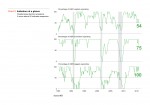Economy
When agriculture and energy industries are excluded, capital investment is robust.
While less often noted, falling prices of agricultural commodities have had an equally negative effect on spending for farm structures and agricultural machinery. From the fourth quarter of 2013 through the first quarter of 2015, investment in farm structures fell by about a quarter while investment in farm equipment dropped by more than half.
Overall business investment in structures and machinery fell to just a 0.9 percent growth rate for the year through the third quarter 2015. But when agriculture and energy industries are excluded, business spending on structures and machinery grew at a surprisingly robust annual rate of 8.5 percent over that period (Chart 1). Among industries still investing in structures at a healthy rate are: commercial office space, lodging, and amusements and recreation. Investment in high-technology equipment, some types of industrial machinery, and transportation equipment also remains strong.
Click here to receive email notifications when the latest Business Conditions Monthly is available.
Economic Outlook
To update our Business-Cycle Conditions model, we reviewed and enhanced three areas. First, we evaluated our 24 indicators for efficacy and replaced eight: five Leaders, one Coincider, and two Laggers. Next, we developed a quantitative algorithm to identify turning points in each indicator. Finally, we adjusted the calculation of the final index to better represent the indicators’ overall performance. For a full description of the changes, see the January 2016 Research Brief, “Revising AIER’s Business-Cycle Conditions Model” (https://www.aier.org/revising).
Our updated model indicates a relatively low risk of recession as consumers drive growth despite worries over things like share prices. In our latest evaluation, 54 percent of our leading indicators were on an upward trend, in the same ballpark as the 56 percent trending higher in November with our old model. December marked the 76th consecutive month at or above 50 percent. Consistent readings above the midpoint suggest a low probability of recession over the next six to 12 months. Conversely, a drop below 50 percent may indicate an increased chance of contraction.
The proportion of expanding coincident indicators slipped to 75 percent in December, following two straight months at 80 percent using the old model. But all our lagging indicators were expanding (Chart 2).
Among the individual Leaders indicators, several show strong favorable trends, including consumer goods new orders, housing permits, the yield curve, heavy truck unit sales, and retail sales. These trends support our analysis that the U.S. consumer is leading the economy forward.
On the negative side were weak trends in manufacturers’ sales-to-inventory ratios, share prices, consumer sentiment, and debit balances in broker-dealer margin accounts. The poor performance by stocks and margin balances may reflect rising uncertainty amid recent volatility and unsettling geopolitical events.
Overall, with a reading closer to, but still above 50, the revised model confirms our view that the U.S. is on a sustainable, moderate growth path. However, the outlook is somewhat fragile as strong crosscurrents affect various parts of the economy.
Click for interactive Indicators at a Glance (on mobile device turn to landscape)
Next/Previous Section:
1.Overview
2. Economy
6. Pulling It All Together/Appendix




